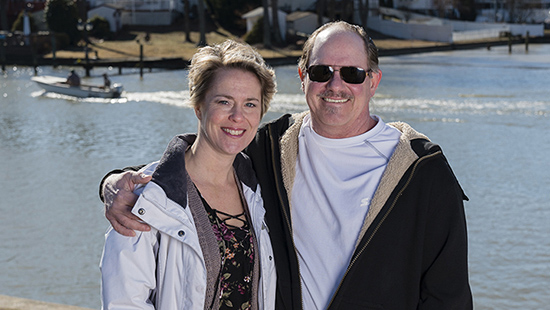Heart Failure, VAD Patient John Wise
When John Wise started experiencing severe chest pain, he immediately sought help at a local hospital, where doctors determined that he had suffered a heart attack.
He then underwent a diagnostic cardiac catheterization, a test that determines how well the heart is working.
The test determined that Wise’s heart had several blockages and was functioning at 20 percent of the capacity of a healthy heart.
Surgeons at another hospital performed a quadruple coronary artery bypass.
Although the bypass surgery went perfectly, Wise’s heart muscle was still in bad shape. It was difficult for doctors to stabilize him, and he was placed on life support.
Wise’s doctors consulted with the team at UMMC Heart and Vascular Center, which sent an ambulance equipped with a special life-assist machine called ECMO (short for extracorporeal membrane oxygenation) to transport Wise to UMMC.
Once there, Wise’s family met with Bartley Griffith, MD, a UMMC cardiac surgeon and professor of surgery at the University of Maryland School of Medicine, to discuss the best course of action.
Only one thing was certain: Wise’s heart was dying.
Wise’s sister, Tammy Baker, made the decision for Wise to undergo ventricular assist device (VAD) surgery. VADs are temporary pumps that are typically installed on one side of the heart to replace lost pumping function, and allow the heart muscle to heal. Wise’s heart was so sick that he needed a unique biventricular assist device (BiVAD) installed on both sides of his heart.
UMMC’s robust VAD program offers a number of types of VAD systems to fit the needs of each patient and includes a team of VAD engineers who monitor patients 24/7, a level of support not found at many heart centers.
After the successful procedure and round-the-clock monitoring and adjustments, Wise’s heart started to bounce back.

“Remarkably, John’s heart was back to 40 percent functionality within days of surgery,” Dr. Griffith said. “When we determined he was well enough to remove the device, his heart function stayed stable on its own.”
Wise persevered through numerous complications, including infections, a case of pneumonia and severe blood loss. He had great support staff at UMMC to help him relearn how to walk and eat, and make sure he was well enough for discharge after a long two months at the hospital.
Wise, now 54, is a Heart and Vascular Center patient for life.
“I am so thankful to everyone involved that had given me a new lease on life. Although I do not remember the first seven weeks of my stay [due to being on life support], I can never thank everyone enough for saving my life,” Wise said.
John’s story was published in our Spring 2018 edition of Maryland’s Health Matters, a quarterly publication that provides great health information from our University of Maryland Medical System hospitals.

